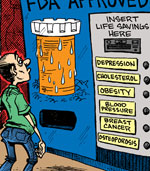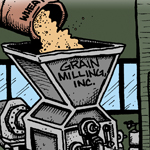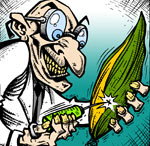What Are the Best Sources of Vitamin D?
| Share on Facebook | Share on Twitter | Share on Google+ |
Most people have heard two things about sources of vitamin D. One is that human skin can use sunlight to make this "sunshine vitamin." The other is that vitamin D is essential to fighting infection, reducing the risk of cancer, and building healthy bones. But do we need supplemental vitamin D, and if we do, what are the best sources?
Why Many People Need Supplemental Sources of Vitamin D

Scientists used to assume that anyone who got 20 to 40 minutes of sunlight every day made enough vitamin D for all their body's needs. (The skin only makes vitamin D when the UV index is 4 or higher.) It turns out this is not so. Many more people than scientists originally thought need additional vitamin D:
- People who have naturally dark skins make relatively little vitamin D.
- People who have disturbances of the parathyroid glands (which transform the storage form of vitamin D, vitamin D3, into the active form of vitamin D, vitamin D2) have little useable vitamin D.
- And some people who spend a lot of time in bright sun just don't make a lot of the vitamin.
Researchers discovered that 51 per cent of visibly tanned surfers and skate boarders in Hawaii, which enjoys bright sunshine all year round, had low vitamin D levels. On the other hand, other researchers found that women in Wisconsin in the winter had normal levels of vitamin D, if they took vitamin D supplements. Despite the fact that our bodies can make much of the vitamin D we need, a little "vitamin D insurance" is usually a good idea. Who needs extra vitamin D?
- People who live in cloudy climates. On a cloudy day, the skin makes about 50% as much vitamin D.
- People who use sunscreen. Covering the skin with sunblock with an SPF of just 8 is enough to reduce vitamin D production by 95%. The UVB rays, which are also thought to be connected to skin cancer, are the spectrum that activates production of the vitamin.
- People who live in extremely hot climates that encourage them to stay indoors. Vitamin D deficiency is surprisingly common in the US state of Georgia.
- People who are over 70. After age 70, the skin contains up to 75% less 7-dehydrocholesterol, the chemical the body activates with sunlight to make vitamin D.
- People who take statin drugs to lower cholesterol. Their skin has less of the 7-dehydrocholesterol used to make vitamin D, and their livers are so busy dealing with the statin drugs that they do not transform vitamin D into calcium-regulating hormones.
- People of Mediterranean, Middle Eastern, Hispanic, South Asian, or African ancestry. The darkest skin makes only about 10% as much vitamin D as fair skin.
But it is not especially easy to get enough vitamin D even from the best vitamin D-rich foods.
The Challenges of Getting Vitamin D from Food
There are several foods that are relatively rich in vitamin D. These include butter and cream from cow's milk and whole cow's milk, even if vitamin D is not added during processing, fish liver, beef liver, and catfish, eel, mackerel, salmon, and sardines. The exact amount of vitamin D in these foods varies tremendously:
- A 3.5 oz/100 g serving of mushrooms provides about 14 IU of vitamin D. Mushrooms are the only vegan source of the vitamin.
- A 3.5 oz/100 g serving of beef liver provides about 15 IU of vitamin D.
- An egg provides about 60 IU of vitamin D.
- A 3.5 oz/100 g serving of eel provides about 200 IU of vitamin D.
- A 3.5 oz/100 g serving of tuna provides about 235 IU of vitamin D.
- A 3.5 oz/100 g serving of mackerel provides about 250 IU, the same size serving of salmon, 350 IU, catfish, 500 IU.
A tablespoon of cod liver oil packs nearly 1500 IU of D, which is more than your body needs for maintenance for an entire day (which is as often as most people want to take it). If you are vitamin D-deficient, then taking cod liver oil three times a day (are you thinking "Yum?") is enough. But consider how much of other foods you need to make up a vitamin D deficiency with 5,000 IU a day:
- 3.5 kilos/7.7 pounds of mushrooms,
- 3.3 kilos/7.0 pounds of beef liver, or
- 83 whole eggs.
Obviously, except for cod liver oil, there are no foods that are sufficiently rich in vitamin D to make up a vitamin D deficiency. That's why supplements are so useful.
How to Get Vitamin D from Supplements
Getting vitamin D from supplements is blissfully easy—and inexpensive. Just take 5,000 IU a day to treat deficiency, or 1,000 to 2,000 IU a day for maintenance, especially in the winter. At these levels, you won't overdose, and you will spend very little money for a very important nutritional protection.
Selected Reference:
Institute of Medicine (IOM). Dietary Reference Intakes for Calcium, Phosphorus, Magnesium, Vitamin D, and Fluoride (1997) Access date: 01-16-2011.
-
Skin CareMen Skin Care
-
Free ResourcesFree eBooks
-
Health is not a condition of matter, but of Mind.Mary Baker Eddy
-
Featured Health Supplement
 The restoration and maintenance of normal organ and brain function and a strong immune system is the key to vibrant health and in
avoiding premature-aging!
The restoration and maintenance of normal organ and brain function and a strong immune system is the key to vibrant health and in
avoiding premature-aging!
-



















